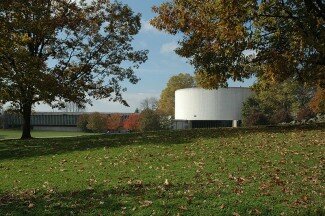Persevering preservationists: Cyclorama Building gets a reprieve
A decade ago, Christine Madrid French, a one-woman modern architecture-saving dervish, landed on the cover of C-Ville for her attempts to save Gettysburg’s Cyclorama Center, the 1961 visitor’s building designed by noted modernist architect Richard Neutra and his partner Robert Alexander. It appears Madrid has finally succeeded, as a federal court in Washington has halted the Park Service’s demolition plans.
Last month, U.S. District Court Judge Thomas Hogan ruled that the U.S. National Park Service failed to comply with the National Environmental Policy Act, NEPA, before deciding to tear down the building and ordered the agency to consider alternatives. A year earlier, U.S. Magistrate Judge Alan Kay also ruled in favor of French and company, ordering the Park Service to re-think its plans.
“Two federal judges have now looked at this case, and both have concluded that the Park Service must comply with federal law before taking any action,” says lawyer Matthew Adams with San Francisco-based law firm of Sonnenschein, Nath and Rosenthal LLP, which represented French and the architect's son Dion Neutra, pro bono. Adams adds that he hopes the ruling will end of years of litigation and launch a discussion on how to preserve the building.

A "sky-bridge" with transluscent-panel balustrades leads from the Cyclorama Gallery ramp to the second floor lobby and out onto the rooftop viewing platform overlooking the battlefield.
PHOTO BY BORIS STAROSTA
In 1996, National Park Service officials announced they were going to demolish the building, which was built to accommodate a massive “cyclorama” of the famous Civil War battle, a 400-by-50 foot circular image depicting Pickett’s Charge by French artist Paul Philippoteaux. Despite a move of the painting to the new Gettysburg National Park Museum and Visitor Center in 2008, French and other preservationists argued that the unusual original structure was worth saving. French points out that the Gettysburg’s is one of only four "cyclorama" buildings in the United States. It was one of the largest commissions for Neutra, a master of glass and steel whose works include the Lovell House in Los Angeles and the Kaufmann Desert House in Palm Springs.
“This ruling recognizes that great modern architecture is an important historic resource, and that it should be valued and protected under federal law,” says French, who was also famously featured in a Hook cover story for trying to protect Charlottesville's modernist gems, including U-Hall, the Import Car Store, and the Terrace Cinema, the last of which was demolished in 2007 as part of the proposed $30.5 million Hillsdale Drive Extension.
“We hope they revisit the idea of reusing the building,” says Dion Neutra. “My father’s vision for the building was to address the notion of reconciliation, as Lincoln did in his Gettysburg Address.”
However, as French points out, the building may still be in jeopardy.
“Despite this favorable ruling, the future of the building is not secure,” says French, who encourages anyone interested in advocating a re-use for the building to visit architect Jason Hart’s website at modernpreservation.com, where several possibilities for re-use have been outlined. One can also visit French’s website on the Cyclorama Building at mission66.com/cyclorama.

A classic image of the interior of the building captured in 1962.
PHOTO BY JACK BOUCHER, NATIONAL PARK SERVICE

11 comments
great building and great job
I used to work for the National Park Service, so I am a preservationist as heart, but I just can't justify saving this building. I worked in the Cyclorama Center, and it was not a well designed building. It had all these "innovative" features that never worked. The front of the auditorium and the glass wall adjacent to it were supposed to slide open, but the building promptly settled after construction, and the sliding walls never opened after its first year of operation. A reflecting pool was supposed to be on the roof, which would cascade down to another pool in front of the building. Naturally, it leaked and had to be removed.
The worst part was that it was always humid and malodorous in the building, no matter the air conditioning.
Yes, some modern architecture should be preserved, but the Gettysburg National Military Park does not exist to preserve modern architecture. It has a specific story to tell, and that is the battle and the Civil War.
I've heard that the Cyclorama Center helps tell us about how we as a people commemorate our past. True, but once again, that is not the mission of the Gettysburg NMP. Such an examination is too academic and remote for the average visitor that arrives on the battlefield and the Ziegler's Grove area attempting to get a picture of the Battle of Gettysburg.
That and most other monuments of the "Fin de Siecle" era of Confederate revanchism represent a mostly bygone time of nostalgia for the "lost cause". Part of me would like to see them all, Monument Ave. in Richmond included, taken down and recycled, but another part says maybe they should remain as memorials to past transgressions. Of course that would imply new signage and a different context for the display of these things. Maybe someday they will all be consolidated in a variation of the Holocaust Museum.
I have little use for the recasting here in the South of the Civil War as having nothing to do with slavery, instead being about some nebulous notion of "states rights". What all these people deny is the reality that absolutely all of those "rights", each and every one without exception, loop right back to the maintenance of a slave economy. An enjoyable mental exercise is the contemplation of "what if" scenarios about what things would be like had the South "won", which is to say they had come to terms and secured their right to set up their parallel universe of an independent country. In many ways the modern political jawboning between reaction and progressivism is a Groundhog Day replay of the balancing act that went on for decades before 1860. If the South had won independence, it would have probably remained that way and we'd sure have two very different countries today, wouldn't we?
I have spent more time in this building than I care to remember. First off, it really does not fit in with the location at all. It sticks out like a sore thumb. Secondly, the building was either too cold or too hot, and leaked like a sieve. Birds and heaven only knows what other sort of wildlife (rats, possums?) lived in the roof and walls. I have vivid memories of sitting next to a wall in the auditorium listening to some critters scratching around inside. Ick. And there were features like moving walls that didn't work--never worked as I was told. The painting suffered a lot of damage because of the environment it was in. I understand the son's affection for his late father and his father's work, but please, this building needed to go a long time ago. Like the Electric Map, its time has come and gone. In fact, move it and the Electric Map to someplace else. Both are loaded with asbestos. The sentimentalists can have them.
The title of this article made me cross my eyes
Having grown up near enough to Gettysburg to have been frequently hauled there as a child in the 60's, the Cyclorama building was just creepy. At least racing under the rock in Devil's Den was creepy-daring fun.
The Gettysburg battlefield has always been cluttered. Civil War soldiers themselves began the process during the battle: marking where they'd been and comparatively soon thereafter erecting monuments where their companies had fought. It's challenging to envision the battle itself because the landscape is so altered by monuments to the soldiers who fought there. Though they are an impediment to understanding the battle, I would never advocate that they be removed. They flow from the battle itself and are eloquent of the feelings of the soldiers who fought there. The Cyclorama is a century later and devoid of connection to the battle. The Cyclorama is faux history; the battlefield itself is the real deal.
This lady sure spends an awfull lot of time and energy trying to save ugly buildings. I mean, the Terrace Cinema? Seriously?!
Wasn't the Terrace Cinema next to Kmart? And pretty much falling apart?
Worse the building never did what it was supposed to, which was to display the Cyclorama Painting. In order to fit the building painting itself had to be altered by cutting out a sixteen foot section and the sky portion altogether. The painting couldn't be hung properly because there was not enough space. To add insult to injury the architect essentially used the top of the painting as an air conditioning filter. The building itself never fit in with its environment and ironically today looks severely dated. Not so great building, not so great job.
Tear the ugly thing down, and while we're at it, sell off every civil war battlefield monument in the country. The soldiers are all gone and the war is over; there's nothing to see there. This country is so hung up on "preserving" places where events, "mostly unimportant brought about by rulers, mostly knaves, and soldiers, mostly fools", took place. If the rest of the world were as concerned with preserving former battlefields, the population would have no place to live. That cyclorama is ugly as home made sin and as architecturally significant as an original golden arches McDonalds.
Angel Eyes,
Thank you for saying this.
How do you feel about "Lee Park," erected a half-century after that war?
I'd like to pull that monstrous imposition down.